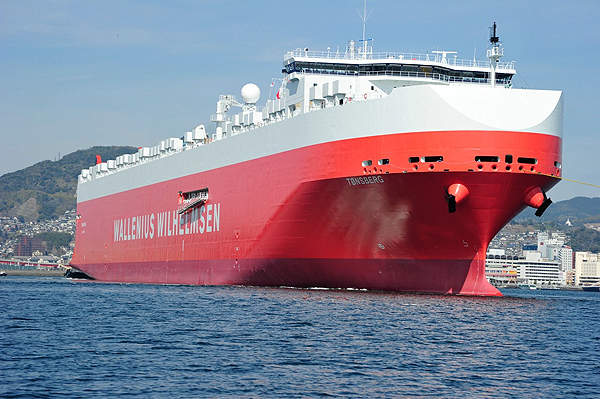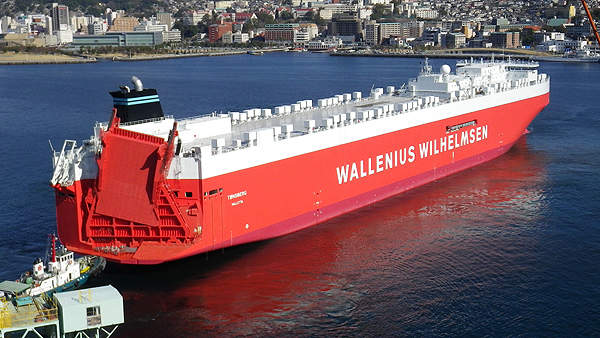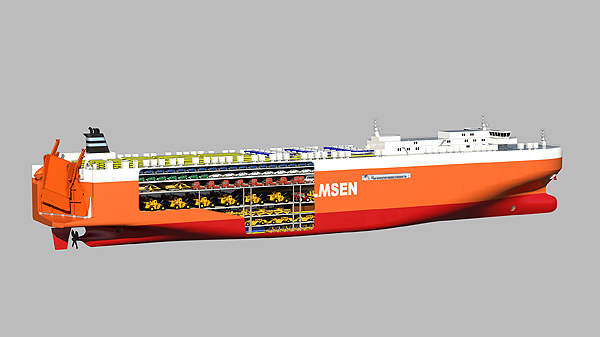The world’s largest roll-on / roll-off vessel, MV Tønsberg, is the first of four Mark V class Ro Ro vessels of the Norwegian shipping company Wilh. Wilhelmsen. Built by Mitsubishi Heavy Industries, Tønsberg is designed to transport high and heavy cargo loads.
MV Tønsberg was launched in March 2011, in commemoration of Wilh. Wilhelmsen’s 150th anniversary.
MV Tønsberg’s innovative design and Mark V concept
Based on the Mark V design concept, Tønsberg incorporates an innovative low double bottom hull. The ship features six fixed heavy decks and three hoistable decks. The hull lines are optimised for low resistance in rough waters.
The fuel oil is stored in protected tanks installed forward and aft of the hull.
Tønsberg has an overall length of 265m, moulded breadth of 32.26m and a design draft of 11m. Gross tonnage of the ship is 76,500gt. The vessel can accommodate a crew of 36 people in two tiers on the weather deck.
The accommodation block also includes public spaces, offices and living quarters. A free fall lifeboat (aft) is accessible through a safe emergency walkway from the accommodation section.
Onboard systems and equipment, including a chill water air conditioning system, water ballast pumps and separate light zones, are designed to minimise energy consumption. Drip trays are installed to collect the possible leakage from hydraulic cylinders. The ballast water treatment unit and bilge water separator reduce pollutant discharges into the sea.
Cargo handling systems of the Norwegian Ro Ro vessel
The cargo handling systems aboard MV Tønsberg allow the loading and unloading of cargo such as high and heavy rolling cargo, non-containerised cargo, break-bulk, special project cargo and cars. All cargoes are loaded and off-loaded over a stern quarter ramp. The main deck offers a higher clear height than other Ro Ro vessels of this type. Internal ramps are arranged in sequence to enable the efficient and safe movement of cargo.
The fixed and hoistable-type internal ramps allow movement between decks. Liftable decks are controlled by electric winches installed under each deck panel. The ramp system enables the simultaneous loading and off-loading of cargo from all decks. The weather deck is provided with a four metre wide ramp, to avoid the use of shore-based cranes for loading of cargo.
Cargo capacities of the world’s largest roll-on / roll-off vessel
The vessel offers total deck area of 50,335 square metres, of which 31,250 square metres are dedicated for high and heavy cargo. The strengthened stern ramp can hold 500t of cargo while the weather deck can accommodate aquavit containers, windmill blades and yachts. The vessel can carry a cargo volume of about 138,000 cubic metres.
The ship has two pairs of water ballast (WB) tanks connected to anti-heel system. The fuel oil tanks are well protected to withstand the impact of grounding and collision. The tank capacities of the vessel are: WB tanks – 16,080 square metres, fuel oil tanks – 5,500 square metres, diesel oil tanks – 650 square metres and fresh water tanks – 475 square metres.
Propulsion and engine of Wilh. Wilhelmsen’s MV Tønsberg
The ship is powered by an electronically controlled slow speed B&W seven cylinder L70ME-C8 engine, which drives a single fixed pitch propeller.
The propulsion system also integrates a low resistance rudder and transverse thrusters for high manoeuvrability. The vessel has a service speed of 20.25kt.
Tønsberg is fitted with a 1,200kW steam turbine generator and 1,100kW shaft generator for electric power supply during the transit. Three 2,400kW auxiliary generator sets supply electricity for the vessel in the port and throughout manoeuvring.
The auxiliary systems and fuel tanks are designed for operation on low sulphur heavy fuel oil and marine diesel oil. The turbo generator system is expected to reduce the annual fuel consumption by about five to six percent, resulting in fewer CO2, SOX and NOX emissions.










